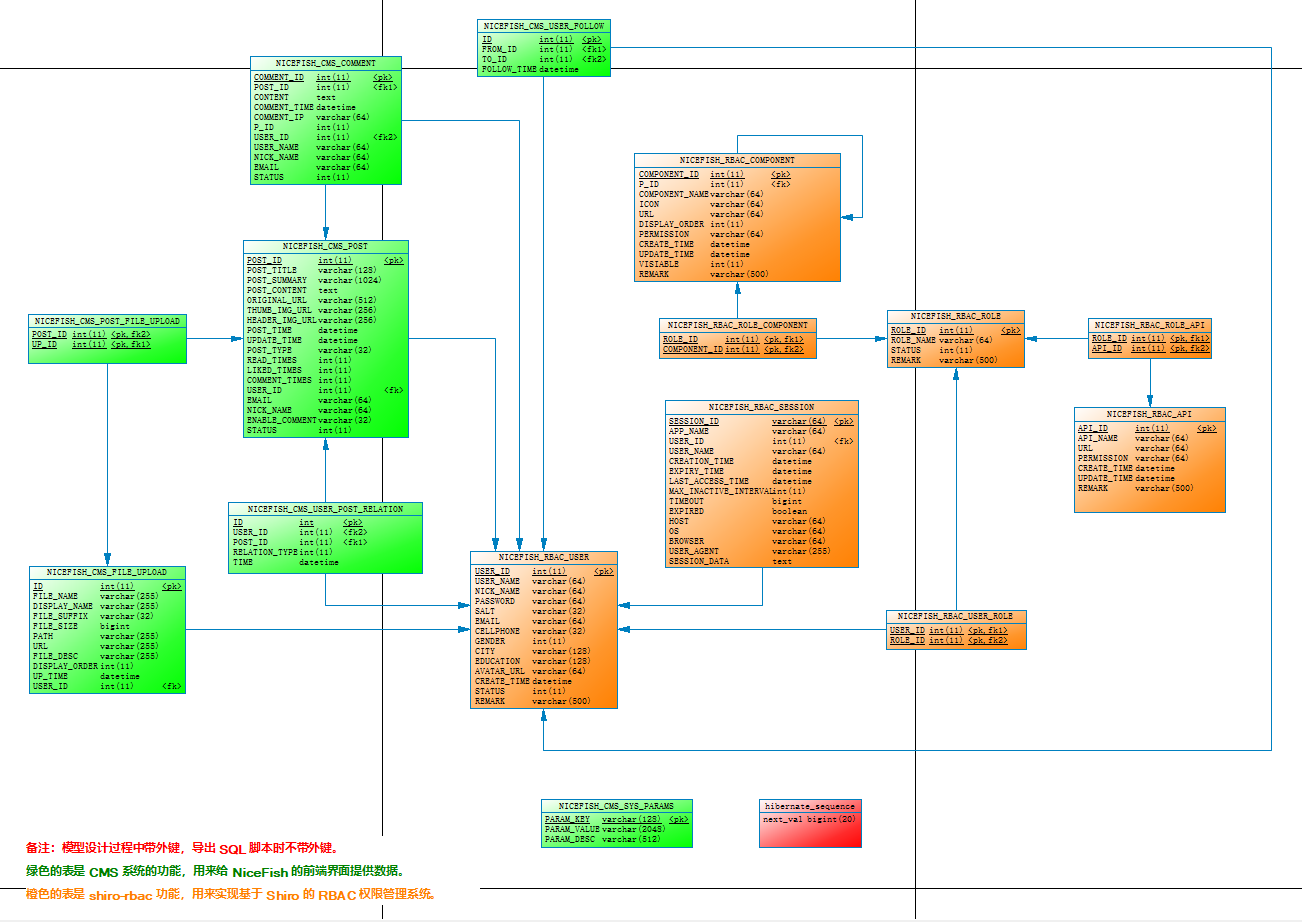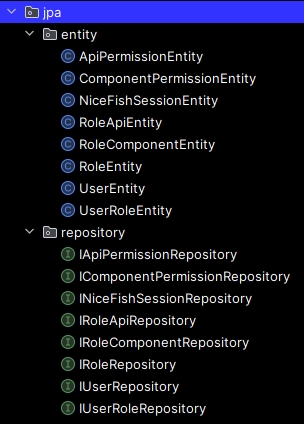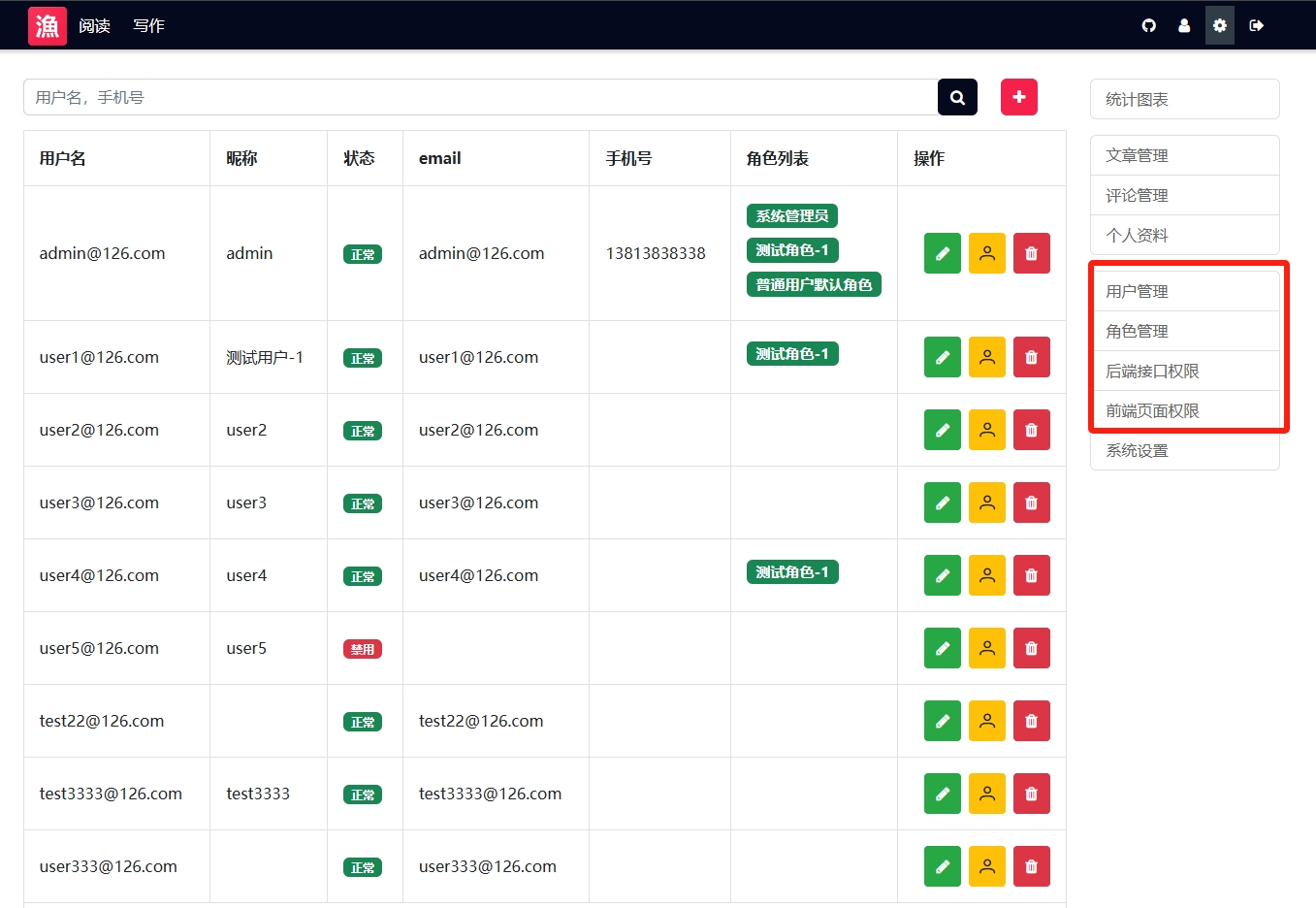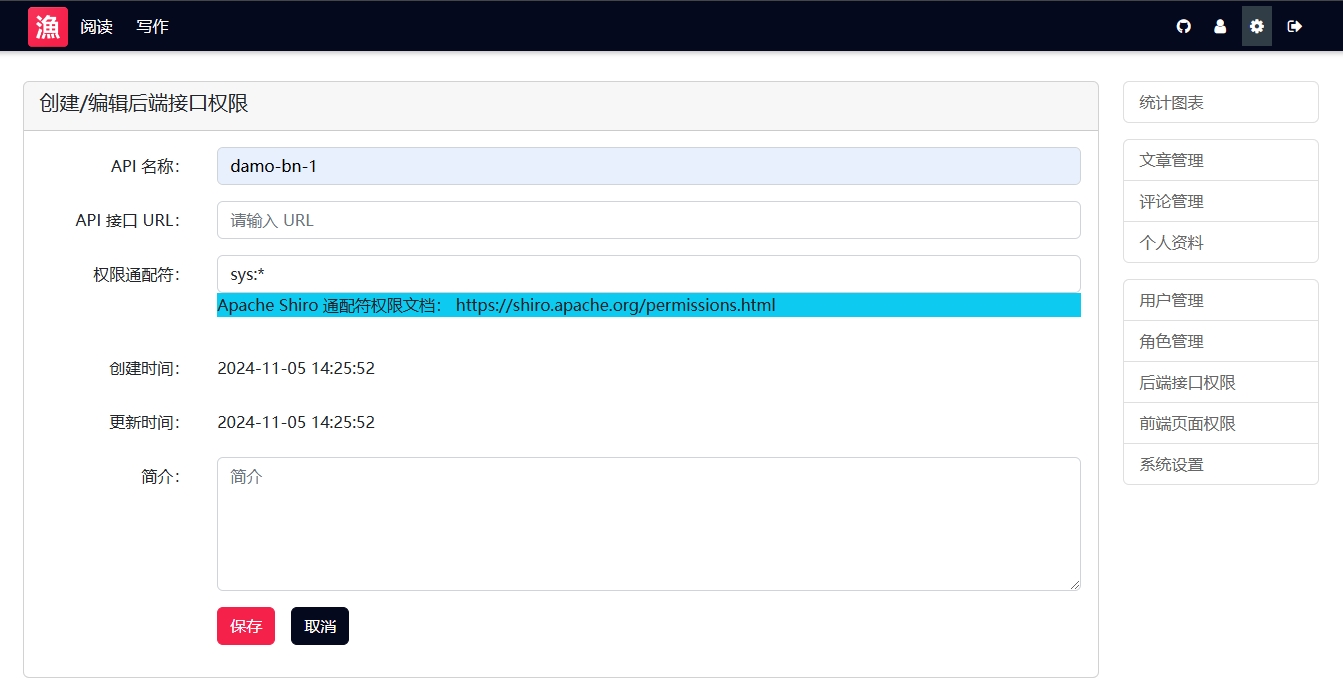《Apache Shiro 源码解析》- 12.整合实战:基于 Shiro 框架的 RBAC 权限控制系统
原创《Apache Shiro 源码解析》- 12.整合实战:基于 Shiro 框架的 RBAC 权限控制系统
原创

12.整合实战:基于 Shiro 框架的 RBAC 权限控制系统
在前面的章节中,我们已经详细分析了 Shiro 的架构和源码。在本章中,我们将会用 Shiro 框架来实现一个完整的 RBAC 权限控制系统。这个系统的整体功能是:让用户可以自定义服务端 API 的权限和前端页面组件的权限。
以下是本章的内容结构:
- RBAC 的基本概念
- 设计物理模型
- 实现 Entity 、 DAO、 Service 与 Controller
- 实现 Realm 和 SessionDAO
- 服务端 API 权限控制
- 前端页面组件的权限控制
- 最终效果与开源项目
RBAC 的基本概念
RBAC(Role-Based Access Control)是一种权限管理模型,这种设计思想起源于 20 世纪 70 年代,但直到 1992 年 才由 David Ferraiolo 和 Richard Kuhn 在他们的研究论文中正式提出并加以推广。
2001 年,RBAC 被美国国家标准与技术研究院(NIST)标准化,成为一种公认的访问控制模型。经过几十年的发展,RBAC 已广泛应用于企业级系统和信息安全中。
RBAC 模型的核心思想是:用户与角色关联,角色与权限关联,通过角色间接管理用户的权限。这种模型允许管理员通过管理角色而非单个用户权限,来实现更有效的权限控制。
- 用户(User):系统中的个人或实体,可以是实际的人或自动化系统,在 Shiro 中的概念是 Subject 。
- 角色(Role):一组权限的集合。角色被分配给用户,用户通过角色来获得相应的权限,在 Shiro 中也叫 Role 。
- 权限(Permission):对系统资源的访问控制标识,定义了用户能够执行的操作,在 Shiro 中一般会被定义成通配符权限表达式。
- 资源(Resource):系统中需要被保护的对象,如数据库、文件系统、网页等,在 Shiro 中会被定义成 Realm 。
设计物理模型
基于 RBAC 的概念,以及 Shiro 框架中的基本组件,我们来设计系统的物理模型。为了获得一个更加真实的业务系统,这个设计中带有一个简单的业务场景:编写和发布文章。整体的物理模型如下图所示:

其中,橙色的表是与 RBAC 相关的核心表,关键的几组关系如下:
- nicefish_rbac_user 表与 nicefish_rbac_role 表是多对多关系,通过 nicefish_rbac_user_role 这张中间表进行关联。
- nicefish_rbac_role 表与资源权限表进行关联,也是多对多的关系。
- 这个系统中有两种资源需要进行保护:服务端 API 、前端页面组件。于是我们定义两张权限表: nicefish_rbac_api(定义服务端接口权限表达式) 与 nicefish_rbac_component(定义前端页面组件的权限表达式)。
- nicefish_rbac_session 表用来持久化会话。
在设计完物理模型之后,可以导出建库脚本,本章描述的内容和示例代码都已经在 MySQL(MariaDB) 数据库上跑通,如果读者需要支持其它数据库,需要自己测试兼容性。
实现 Entity 、 DAO、 Service 与 Controller
在设计完物理模型之后,我们就很自然地获得了相关的 Entity 和 DAO ,我们基于 JPA 来实现,整体代码结构如下:

这些都是 JPA 的基本内容,没有什么特殊的写法,这里仅仅展示 UserEntity 的大致代码:
//...
@Entity
@DynamicInsert
@DynamicUpdate
@Table(name = "nicefish_rbac_user")
public class UserEntity implements Serializable {
@Id
@GeneratedValue(strategy = GenerationType.IDENTITY)
@Column(name="user_id", updatable = false)
private Integer userId;
@Column(name="user_name",nullable = false,updatable = false)
private String userName;
@Column(name="nick_name",nullable = false)
private String nickName;
@Column(name="password",nullable = false)
private String password;
@Column(name="email")
private String email;
@Column(name="cellphone")
private String cellphone;
@Column(name="gender",columnDefinition = "int default 0")
private Integer gender=0;
@Column(name="city")
private String city;
@Column(name="education")
private String education;
@Temporal(TemporalType.TIMESTAMP)
@Column(name="create_time",updatable = false)
@JsonFormat(shape = JsonFormat.Shape.STRING, pattern = "yyyy-MM-dd HH:mm:ss")
private Date createTime;
@Column(name="avatar_url")
private String avatarURL;
@Column(name="salt")
private String salt;
@Column(name="status",columnDefinition = "int default 0")
private Integer status=0;
@Column(name="remark")
private String remark;
@JoinTable(
name="nicefish_rbac_user_role",
joinColumns={@JoinColumn(name="user_id",referencedColumnName="user_id")},
inverseJoinColumns={@JoinColumn(name="role_id",referencedColumnName="role_id")}
)
@ManyToMany(fetch = FetchType.LAZY)
private List<RoleEntity> roleEntities;
//省略所有 getter 和 setter
}在以上代码中, @ManyToMany 是一个关键的处理,在 OO 模型中, UserEntity 和 RoleEntity 互相持有对方的实例,所以这里必须加上 fetch = FetchType.LAZY ,否则在把查询到的 Java 对象转换成 JSON 字符串的时候会出现循环依赖异常。除了采用懒加载之外,开发者还可以定义自己的序列化类,来避免这种循环依赖问题,示例代码如下:
//...
@JoinTable(
name="nicefish_rbac_role_component",
joinColumns={@JoinColumn(name="component_id",referencedColumnName="component_id")},
inverseJoinColumns={@JoinColumn(name="role_id",referencedColumnName="role_id")}
)
@ManyToMany
@JsonSerialize(using = RoleListSerializer.class)
private List<RoleEntity> roleEntities;
//...以上代码中的 RoleListSerializer 是我们自己编写的序列化工具类,它的逻辑如下:
package com.nicefish.rbac.jpautils;
import com.fasterxml.jackson.core.JsonGenerator;
import com.fasterxml.jackson.databind.SerializerProvider;
import com.fasterxml.jackson.databind.ser.std.StdSerializer;
import com.nicefish.rbac.jpa.entity.RoleEntity;
import java.io.IOException;
import java.util.ArrayList;
import java.util.HashMap;
import java.util.List;
import java.util.Map;
public class RoleListSerializer extends StdSerializer<List<RoleEntity>> {
public RoleListSerializer() {
this(null);
}
protected RoleListSerializer(Class<List<RoleEntity>> t) {
super(t);
}
@Override
public void serialize(List<RoleEntity> roleEntities, JsonGenerator generator, SerializerProvider provider) throws IOException {
//注意这里,我们自己组装 Java 对象,避开转换成 JSON 字符串过程中的循环引用问题。
List<Map> list = new ArrayList<>();
for (RoleEntity roleEntity : roleEntities) {
HashMap obj=new HashMap();
obj.put("roleId",roleEntity.getRoleId());
obj.put("roleName",roleEntity.getRoleName());
obj.put("status",roleEntity.getStatus());
obj.put("remark",roleEntity.getRemark());
list.add(obj);
}
generator.writeObject(list);
}
}相关的 Repository 是标准的 JPA 注解写法,这里不再展示代码。
编写出 Entity 和 DAO 之后,我们可以很自然地编写出对应的 Service 和 Controller ,例如:根据 userId 查询对应的角色列表、根据 userId 查询对应的权限列表、根据 userId 给用户赋予新的权限表达式,等等。这些都是普通的业务逻辑,基本上都是体力活,这里不再展示代码。
实现 Realm 和 SessionDAO
接下来,按照 Shiro 框架的架构,我们需要实现自己的 Realm 和 SessionDAO ,然后在 ShiroConfig.java 中进行配置。
在这个项目中,我们定义了 NiceFishMySQLRealm 和 NiceFishSessionDAO,它们的代码比较简短,完整展示如下:
package com.nicefish.rbac.shiro.realm;
import com.nicefish.rbac.jpa.entity.UserEntity;
import com.nicefish.rbac.service.IUserService;
import com.nicefish.rbac.shiro.util.NiceFishSecurityUtils;
import org.apache.shiro.authc.*;
import org.apache.shiro.authz.AuthorizationInfo;
import org.apache.shiro.authz.SimpleAuthorizationInfo;
import org.apache.shiro.realm.AuthorizingRealm;
import org.apache.shiro.subject.PrincipalCollection;
import org.slf4j.Logger;
import org.slf4j.LoggerFactory;
import org.springframework.beans.factory.annotation.Autowired;
import java.util.Set;
/**
* NiceFish 操作 MySQL 的 Realm 。
* @author 大漠穷秋
*/
public class NiceFishMySQLRealm extends AuthorizingRealm {
private static final Logger logger = LoggerFactory.getLogger(NiceFishMySQLRealm.class);
@Autowired
private IUserService userService;
/**
* 认证
* TODO:这里仅实现了简单的用户名+密码的验证方式,需要扩展其它认证方式,例如:扫描二维码、第三方认证。
*/
@Override
protected AuthenticationInfo doGetAuthenticationInfo(AuthenticationToken token) throws AuthenticationException {
UsernamePasswordToken usernamePasswordToken = (UsernamePasswordToken) token;
String username = usernamePasswordToken.getUsername();
String password = usernamePasswordToken.getPassword()!=null?new String(usernamePasswordToken.getPassword()):"";
UserEntity userEntity;
try {
userEntity = userService.checkUser(username, password);
logger.debug("UserName>"+username);
logger.debug("Password>"+password);
}catch (Exception e) {
logger.error(username + "登录失败{}", e.getMessage());
throw new AuthenticationException(e.getMessage(), e);
}
//用户认证成功,返回验证信息实例。
SimpleAuthenticationInfo info = new SimpleAuthenticationInfo(userEntity, password, getName());
return info;
}
/**
* 授权
* NiceFish 采用 Shiro 字符串形式的权限定义,权限不实现成 Java 类。
* Shiro 权限字符串的匹配模式定义参考 https://shiro.apache.org/java-authorization-guide.html
*/
@Override
protected AuthorizationInfo doGetAuthorizationInfo(PrincipalCollection principals) {
Integer userId= NiceFishSecurityUtils.getUserId();
//TODO:首先尝试从 Session 中获取角色和权限数据,加快授权操作的速度。
//同时需要自己扩展 SessionListener 来同步 Session 数据。
Set<String> permStrs=this.userService.getPermStringsByUserId(userId);
logger.debug(permStrs.toString());
SimpleAuthorizationInfo info = new SimpleAuthorizationInfo();
info.setStringPermissions(permStrs);
return info;
}
}package com.nicefish.rbac.shiro.session;
import com.nicefish.rbac.jpa.entity.NiceFishSessionEntity;
import com.nicefish.rbac.service.INiceFishSessionService;
import org.apache.shiro.session.Session;
import org.apache.shiro.session.mgt.SimpleSession;
import org.apache.shiro.session.mgt.eis.EnterpriseCacheSessionDAO;
import org.slf4j.Logger;
import org.slf4j.LoggerFactory;
import org.springframework.beans.factory.annotation.Autowired;
import org.springframework.util.ObjectUtils;
import java.io.Serializable;
import java.util.Date;
/**
* 扩展 Shiro 内置的 EnterpriseCacheSessionDAO ,操作 MySQL 中的 nicefish_rbac_session 表。
*
* 由于 EnterpriseCacheSessionDAO 实现了 CacheManagerAware 接口, Shiro 的 SecurityManager 会自动把
* CacheManager 缓存实例注入到此类中,所以此类中可以直接操作 cacheManager 缓存实例。
*
* 此实现参考了 spring-session-jdbc 的实现,Session 中的所有 attributes 都会被提取出来并存储到 SESSION_DATA 列中,
* 存储格式是 JSON 字符串。
*
* 此实现不会存储 Session 实例序列化之后的二进制数据,因为在跨业务模块共享 Session 时,如果 Session 中包含了
* 某项目中特有的类,那么其它项目在反序列化时会因为找不到 Java 类而失败。
*
* @author 大漠穷秋
*/
public class NiceFishSessionDAO extends EnterpriseCacheSessionDAO {
private static final Logger logger = LoggerFactory.getLogger(NiceFishSessionDAO.class);
@Autowired
private INiceFishSessionService sessionService;
/**
* 该方法参数中的 session 实例实际上是由 NiceFishSessionFactory.createSession 提供的。
* 运行时调用轨迹:
* SecurityManager -> SessionManager -> SessionFactory.createSession() -> EnterpriseCacheSessionDAO.doCreate(session)
* @param session
* @return
*/
@Override
protected Serializable doCreate(Session session) {
Serializable sessionId = super.doCreate(session);
NiceFishSessionEntity entity = new NiceFishSessionEntity();
entity.setSessionId((String) sessionId);
entity.setCreationTime(new Date());
entity.setLastAccessTime(new Date());
entity.setTimeout(session.getTimeout());
//TODO:把用户对应的 Role 和 Permission 存储到 Session 中。
this.sessionService.saveSession(entity);
return sessionId;
}
/**
* 从 MySQL 数据库中读取 Session ,父层实现会保证先读取缓存,然后再调用此方法。
* @param sessionId
* @return
*/
@Override
protected Session doReadSession(Serializable sessionId) {
//把 entity 上的数据拷贝给 session 实例,TODO: 有更好的工具?
NiceFishSessionEntity entity = sessionService.findDistinctBySessionId(sessionId.toString());
if(ObjectUtils.isEmpty(entity)){
return null;
}
SimpleSession session=new SimpleSession();
session.setId(entity.getSessionId());
session.setTimeout(entity.getTimeout());
session.setStartTimestamp(entity.getCreationTime());
session.setLastAccessTime(entity.getLastAccessTime());
session.setHost(entity.getHost());
session.setAttribute("appName",entity.getAppName());
session.setAttribute("userId",entity.getUserId());
session.setAttribute("userName",entity.getUserName());
session.setAttribute("exprityTime",entity.getExpiryTime());
session.setAttribute("maxInactiveInterval",entity.getMaxInactiveInteval());
session.setExpired(entity.isExpired());
session.setAttribute("os",entity.getOs());
session.setAttribute("browser",entity.getBrowser());
session.setAttribute("userAgent",entity.getUserAgent());
session.setAttribute("sessionData",entity.getSessionData());
return session;
}
/**
* 把 Session 更新到 MySQL 数据库,父层实现会保证先更新缓存,然后再调用此方法。
* 把 SimpleSession 上的数据拷贝给 entity ,然后借助于 entity 更新数据库记录。
* TODO: 有更好的工具?
* @param session 类型实际上是 Shiro 的 SimpleSession
*/
@Override
protected void doUpdate(Session session) {
logger.debug("update session..."+session.toString());
SimpleSession simpleSession=(SimpleSession)session;//Shiro 顶级 Session 接口中没有定义 isExpired() 方法,这里强转成 SimpleSession
String sessionId=(String)simpleSession.getId();
NiceFishSessionEntity entity=this.sessionService.findDistinctBySessionId(sessionId);
if(ObjectUtils.isEmpty(entity)){
entity=new NiceFishSessionEntity();
entity.setSessionId((String)simpleSession.getId());
}
entity.setHost(simpleSession.getHost());
entity.setCreationTime(simpleSession.getStartTimestamp());
entity.setLastAccessTime(simpleSession.getLastAccessTime());
entity.setTimeout(simpleSession.getTimeout());
entity.setExpired(simpleSession.isExpired());
entity.setAppName((String)simpleSession.getAttribute("appName"));
entity.setUserId((Integer)simpleSession.getAttribute("userId"));
entity.setUserName((String)simpleSession.getAttribute("userName"));
entity.setExpiryTime((Date)simpleSession.getAttribute("exprityTime"));
entity.setMaxInactiveInteval((Integer)simpleSession.getAttribute("maxInactiveInterval"));
entity.setOs((String)simpleSession.getAttribute("os"));
entity.setBrowser((String)simpleSession.getAttribute("browser"));
entity.setUserAgent((String)simpleSession.getAttribute("userAgent"));
entity.setSessionData((String)simpleSession.getAttribute("sessionData"));
this.sessionService.saveSession(entity);
}
/**
* 把 Session 从 MySQL 数据库中删除,父层实现会保证先删除缓存,然后再调用此方法。
* NiceFish 不进行物理删除,仅仅把标志位设置成过期状态。
* @param session 类型实际上是 Shiro 的 SimpleSession
*/
@Override
protected void doDelete(Session session) {
logger.debug("delete session..."+session.toString());
NiceFishSessionEntity entity=this.sessionService.findDistinctBySessionId((String)session.getId());
entity.setExpired(true);
this.sessionService.saveSession(entity);
}
}然后我们在 ShiroConfig.java 中进行配置,关键代码如下:
@Configuration
public class ShiroConfig {
//...
@Bean
public NiceFishMySQLRealm nicefishRbacRealm() {
NiceFishMySQLRealm niceFishMySQLRealm = new NiceFishMySQLRealm();
niceFishMySQLRealm.setCachingEnabled(true);
niceFishMySQLRealm.setAuthenticationCachingEnabled(true);
niceFishMySQLRealm.setAuthenticationCacheName("authenticationCache");
niceFishMySQLRealm.setAuthorizationCachingEnabled(true);
niceFishMySQLRealm.setAuthorizationCacheName("authorizationCache");
return niceFishMySQLRealm;
}
/**
* 创建自定义的 NiceFishSessionDAO 实例
* @return
*/
@Bean
public NiceFishSessionDAO sessionDAO() {
NiceFishSessionDAO nfSessionDAO = new NiceFishSessionDAO();
nfSessionDAO.setActiveSessionsCacheName("shiro-activeSessionCache");
return nfSessionDAO;
}
/**
* 创建自定义的 NiceFishSessionFactory 实例
* @return NiceFishSessionFactory
*/
@Bean
public NiceFishSessionFactory sessionFactory() {
NiceFishSessionFactory nfSessionFactory = new NiceFishSessionFactory();
return nfSessionFactory;
}
//...
}这些代码都是 Shiro 框架的基本用法,相关的机制和原理在前面的章节中都已经解释过,这里不再赘述。
服务端 API 权限控制
我们用 nicefish_rbac_api 表来维护服务端 API 的权限,以下是一组测试数据供参考:

前端页面组件的权限控制
类似地,我们用 nicefish_rbac_component 表来维护前端页面组件的权限,以下是一组测试数据:

前端组件稍有不同:页面可能会带有层级结构,所以我们用 p_id 来构建 tree 形数据结构;另外,前端组件在屏幕上显示的时候可能会有顺序要求,所以多了一个 display_order 列,用来定义组件在屏幕上的排列顺序。
最终效果与开源项目
最终,我们就获得了一个完整的项目,可以同时管理服务端 API 和前端页面组件的权限,以下是系统截图:



项目完整的源代码位于 https://gitee.com/mumu-osc/nicefish-spring-boot ,在项目的 README 文档中包含了完整的启动步骤。
本章小结
在掌握了 Shiro 的架构,并且通读了它的源代码之后,在这一章中,我们通过一个实际的项目进行了实战,希望本文对你理解和实现 Shiro 的 RBAC 权限控制系统有所帮助。
资源链接
- Apache Shiro 在 github 上的官方仓库: https://github.com/apache/shiro
- Apache Shiro 官方网站:https://shiro.apache.org/
- 本书实例项目:https://gitee.com/mumu-osc/nicefish-spring-boot
- 本书文字稿:https://gitee.com/mumu-osc/apache-shiro-source-code-explaination
版权声明
本书基于 CC BY-NC-ND 4.0 许可协议发布,自由转载-非商用-非衍生-保持署名。
版权归大漠穷秋所有 © 2024 ,侵权必究。
原创声明:本文系作者授权腾讯云开发者社区发表,未经许可,不得转载。
如有侵权,请联系 cloudcommunity@tencent.com 删除。
原创声明:本文系作者授权腾讯云开发者社区发表,未经许可,不得转载。
如有侵权,请联系 cloudcommunity@tencent.com 删除。
